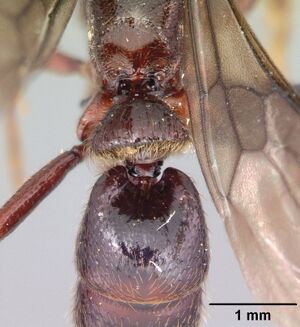Euponera ivolo
| Euponera ivolo | |
|---|---|

| |
| Scientific classification | |
| Kingdom: | Animalia |
| Phylum: | Arthropoda |
| Class: | Insecta |
| Order: | Hymenoptera |
| Family: | Formicidae |
| Subfamily: | Ponerinae |
| Tribe: | Ponerini |
| Genus: | Euponera |
| Species complex: | sikorae |
| Species: | E. ivolo |
| Binomial name | |
| Euponera ivolo (Rakotonirina & Fisher, 2013) | |
The alate queen holotype, the only knonwn specimen, was found foraging on the floor of a high elevation rainforest near the marsh edge of Torotorofotsy in central eastern Madagascar.
Identification
Rakotonirina and Fisher (2013) - Queen. Anterior clypeal margin wide and straight, with slight median notch; posterior surface of petiolar node covered with slender hairs and abundant pubescence; anterior surface of first gastral segment forming shallow cavity; lateral section of head and petiolar node smooth and shiny, with scattered piliferous punctures.
Euponera ivolo is only known from a single winged queen. This species is most similar to Euponera haratsingy based on the presence of a shallow cavity on the anterior face of the first gastral segment and the abundant pubescence on the posterior surface of the node, but can be distinguished easily by the smooth and shiny lateral surfaces of the head and petiolar node. It also can be confounded with E. agnivo, but the straight anterior clypeal margin and compressed petiole node with the posterior surface covered by abundant pubescence render E. ivolo separable from the latter species.
Keys including this Species
Distribution
Latitudinal Distribution Pattern
Latitudinal Range: -18.8708° to -18.8708°.
| North Temperate |
North Subtropical |
Tropical | South Subtropical |
South Temperate |
- Source: AntMaps
Distribution based on Regional Taxon Lists
Malagasy Region: Madagascar (type locality).
Distribution based on AntMaps
Distribution based on AntWeb specimens
Check data from AntWeb
Countries Occupied
| Number of countries occupied by this species based on AntWiki Regional Taxon Lists. In general, fewer countries occupied indicates a narrower range, while more countries indicates a more widespread species. |

|
Estimated Abundance
| Relative abundance based on number of AntMaps records per species (this species within the purple bar). Fewer records (to the left) indicates a less abundant/encountered species while more records (to the right) indicates more abundant/encountered species. |

|
Biology
Castes
Known only from the queen caste.
Images from AntWeb
 
| |
| Holotype of Euponera ivolo. Queen (alate/dealate). Specimen code casent0050330. Photographer April Nobile, uploaded by California Academy of Sciences. | Owned by CAS, San Francisco, CA, USA. |
Nomenclature
The following information is derived from Barry Bolton's Online Catalogue of the Ants of the World.
- ivolo. Pachycondyla ivolo Rakotonirina & Fisher, 2013: 466, figs. 6, 43, 44, 45, 74 (q.) MADAGASCAR. Combination in Euponera: Schmidt & Shattuck, 2014: 87.
Unless otherwise noted the text for the remainder of this section is reported from the publication that includes the original description.
Description
Queen
(1 specimen): HW: 1.88, HL: 1.99, CI: 94, SL: 1.50, SI: 80, PW: 1.48, WL: 2.86, NH: 0.99, NL: 0.69, NW: 1.20, DNI: 172, LNI: 143.
Description: Head subrectangular, the sides broadly convex, with slightly broader posterior portion; posterior margin weakly medially excised. Head dorsum densely and finely reticulate-punctate, the sculpture becoming densely punctulate near posterior margin; lateral section generally smooth and shining between shallow, small punctures. Eyes large and protruding from the surface of head. With head in full-face view, antennal scape not surpassing posterior border of head; anterior clypeal margin widely transverse and straight, slightly medially notched. Mandibles smooth and glossy between sparse piligerous punctures; masticatory margins armed with ten teeth; outer margin of mandibles near the apical portion strongly curving toward the midline.
With mesosoma in dorsal view, thoracic sclerites fully developed; in profile, mesopleural sulcus visible; posterolateral margin of propodeum without a series of sharp teeth or denticles. Lateral surface of mesosoma densely rugulose-punctate. In dorsal view, petiole node approximately twice as broad as long; lateral margins strongly converging to a straight anterior margin. Posterior face of node with a pair of glandular spots covered with dense and long pubescence; long, slender hairs are present around these glands. In lateral view, anterior margin of node inclined posteriorly; subpetiolar process subquadrate anteriorly with hook-like acute angle posteriorly; petiole mostly smooth and shiny. Anterior face of first gastral segment, from junction of tergite and sternite to anterodorsal angle, sloped strongly backwards and forming a shallow cavity which is deeper near the junction and becomes shallower at the anterodorsal angle; cavity with scattered, elongate, slender hairs. With gaster in profile, lateromedial portions apparently projecting anteriorly to form lateral shields for first gastral sternite. Petiole mostly smooth and shiny between small piligerous punctures, first two gastral tergites generally punctate.
Pilosity characterized by long golden hairs which are much denser and more slender on propodeum and petiole node; pubescence abundant and particularly dense on posterior surface of node. Integument shiny with reddish brown color and lighter appendages.
Type Material
Holotype queen: Madagascar, Toamasina, Torotorofotsy, -18.8708, 48.3474, 1070 m, montane rainforest marsh edge, ground forager, 29 Mar 2004 (Malagasy ant team), collection code: BLF10720, specimen code: CASENT0050330 (California Academy of Sciences).
References
- Rakotonirina, J.C. & Fisher, B.L. 2013. Revision of the Pachycondyla sikorae species-group (Hymenoptera: Formicidae) in Madagascar. Zootaxa 3683, 447-485.
- Schmidt, C.A. & Shattuck, S.O. 2014. The higher classification of the ant subfamily Ponerinae (Hymenoptera: Formicidae), with a review of ponerine ecology and behavior. Zootaxa 3817, 1–242 (doi:10.11646/zootaxa.3817.1.1).
References based on Global Ant Biodiversity Informatics
- Rakotonirina J. C., and B. L. Fisher. 2013. Revision of the Pachycondyla sikorae species-group (Hymenoptera: Formicidae) in Madagascar. Zootaxa 3683 (4): 447-485.

